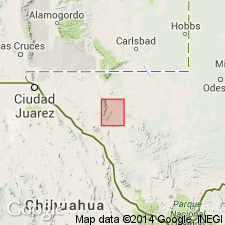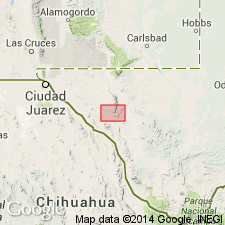
- Usage in publication:
-
- Millican formation*
- Modifications:
-
- Original reference
- Dominant lithology:
-
- Sandstone
- Limestone
- Conglomerate
- AAPG geologic province:
-
- Southwestern Basin-and-Range region
Summary:
Millican formation. Fine-grained red sandstone, cherty limestone, and conglomerate. Unconformably underlies Van Horn sandstone and overlies (relations concealed) Carrizo formation. Age is pre-Cambrian.
Named from Millican's Ranch, 10 mi northwest of Van Horn, [Hudspeth Co.], Sierra Diablo region, TX.
Source: US geologic names lexicon (USGS Bull. 896, p. 1372).

- Usage in publication:
-
- Millican formation†
- Modifications:
-
- Abandoned
Summary:
Pg. 148. Millican formation of Richardson (1914) abandoned. Unit divided into two formations, Hazel sandstone (reinstated) above and Allamoore limestone (new) below. [See entries under Hazel and Allamoore.]
Source: US geologic names lexicon (USGS Bull. 1200, p. 2507).
For more information, please contact Nancy Stamm, Geologic Names Committee Secretary.
Asterisk (*) indicates published by U.S. Geological Survey authors.
"No current usage" (†) implies that a name has been abandoned or has fallen into disuse. Former usage and, if known, replacement name given in parentheses ( ).
Slash (/) indicates name conflicts with nomenclatural guidelines (CSN, 1933; ACSN, 1961, 1970; NACSN, 1983, 2005, 2021). May be explained within brackets ([ ]).

